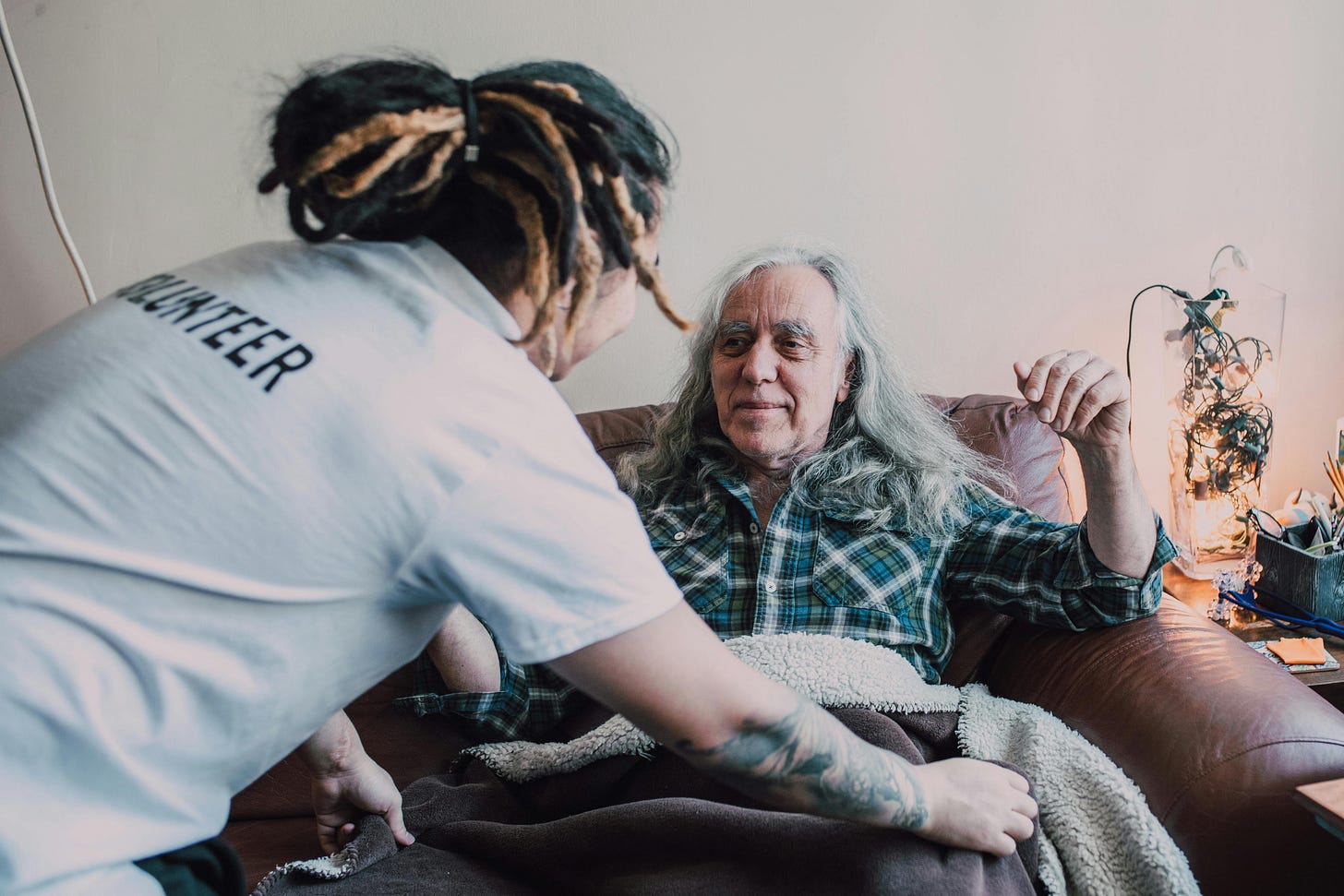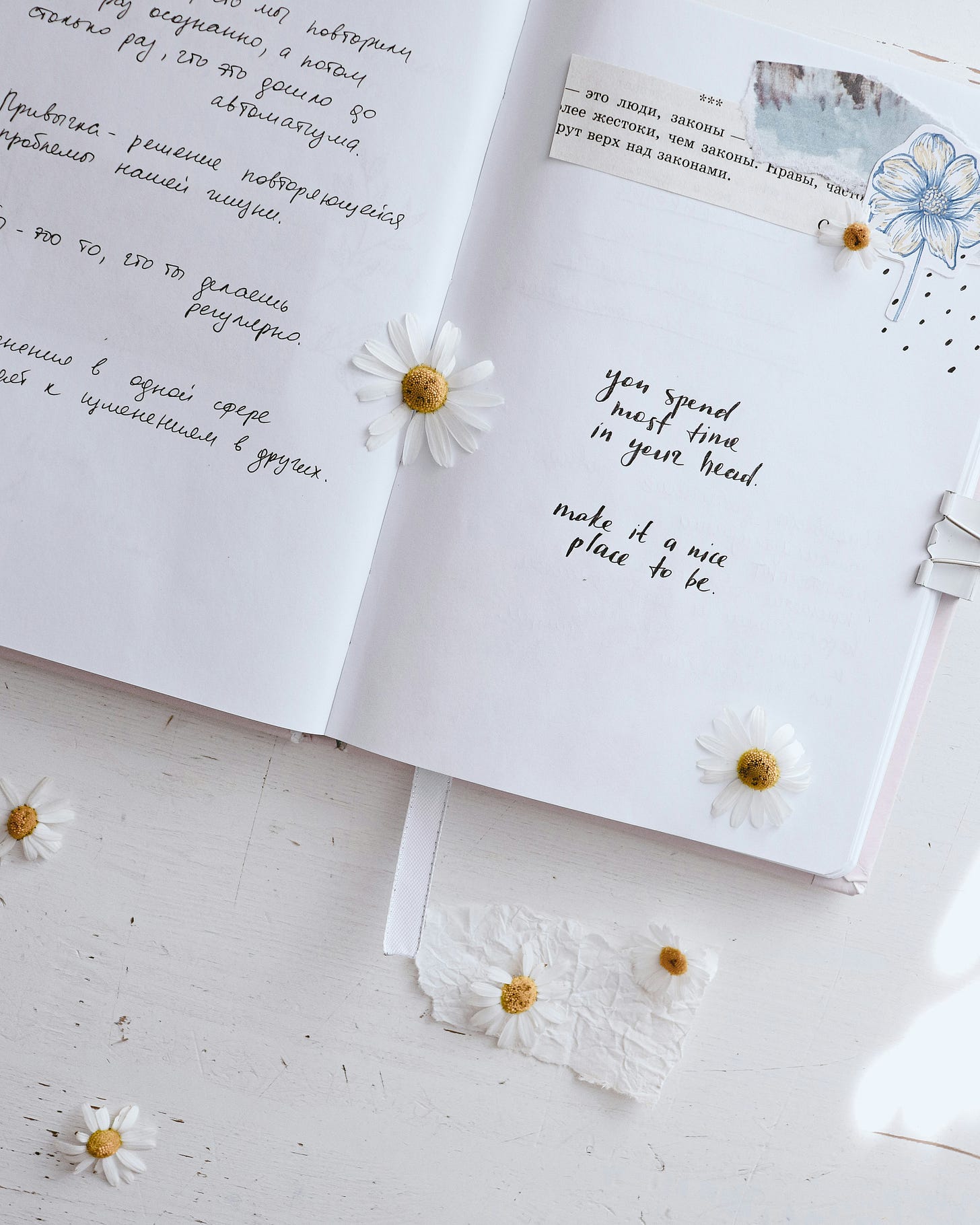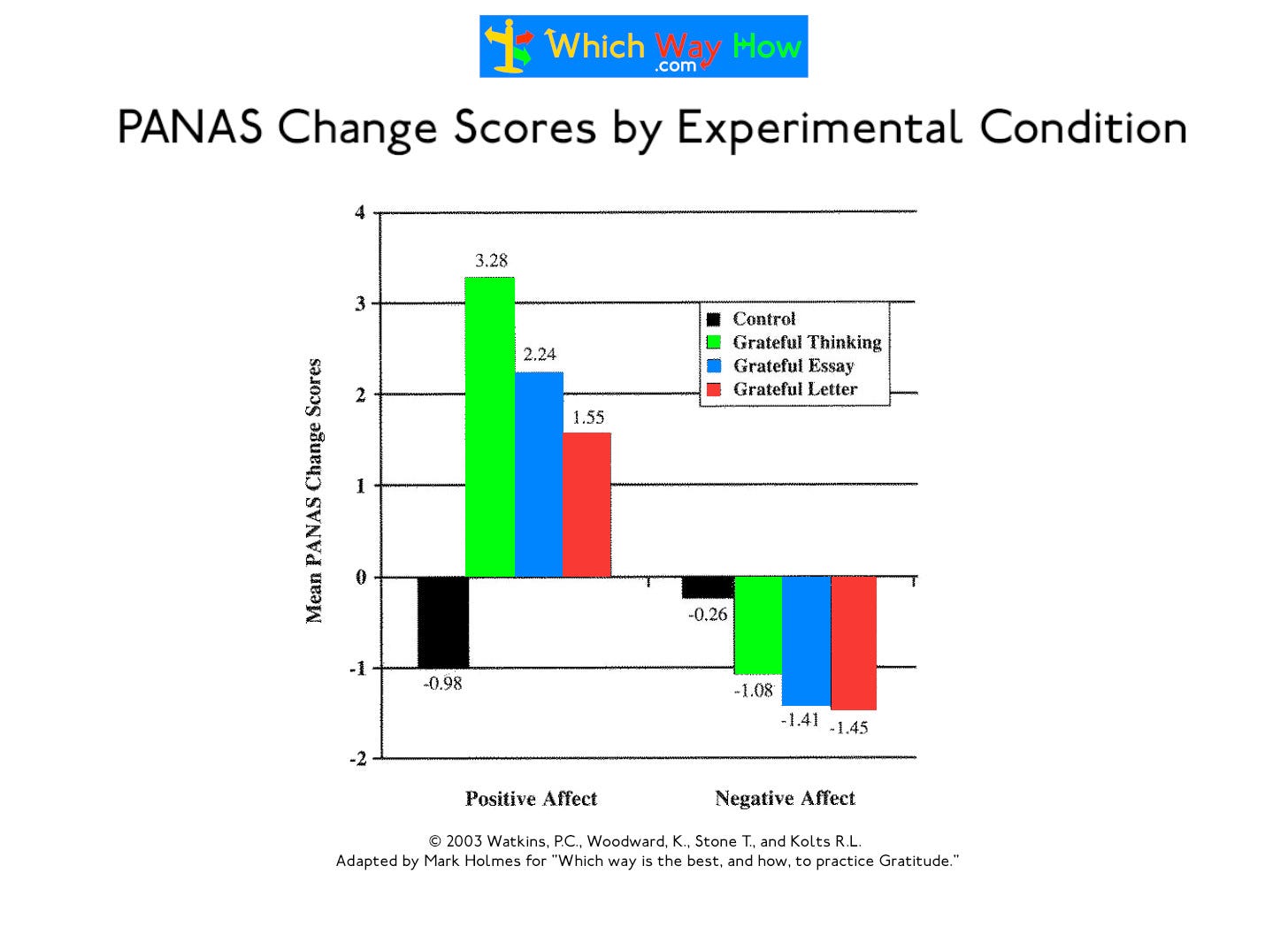Which way is the best, and how, to practice gratitude?
Unlocking the Power of Gratitude: The 5 Best Gratitude Exercises for a Happier Life.
I hope you are well and I am sorry this post, due on 27th November 2024 to celebrate Thanksgiving on the 28th is late, but I had to take some time off due to illness, and, to be honest, a large part was procrastination (see Which way is the best, and how, to conquer procrastination) but I am very grateful to be back to full health!
Isn’t it ironic that the only time I appreciate my health, though, is when I am ill.
I was confined to my bed for a week or so, weak all over--like when you actually have to think about how to get out of bed because it hurts to move--and I couldn’t hug my wife or children for fear of spreading the infection.
I not only felt physically but mentally miserable, and lonely, but it’s surprising how quickly I forgot all that when I was better, and jumped out of bed to hug my kids again. The point is, maybe it was wrong to forget it too quickly?
I feel so grateful to be well again and have my family, but should I have to wait for illness to appreciate my good health and my family? Or, would that mean missing something… If I am, this could be big, and something well worth investigating in greater depth.
“So much to savor, so much to be grateful for. And since I’m not sure of the address to which to send my gratitude, I put it out there in everything I do.” —Michael J. Fox[1]
I have heard of people keeping a gratitude list before but never really seen the point of it. We don’t even have Thanksgiving Day in the UK! But I feel the need to be grateful now, and I want to find out if there are any proven researched benefits of practicing gratitude, and if so, which is the best way and how to do it? Who should I be grateful to? And I wonder if I may even be less susceptible to getting ill in the first place if I practice gratitude? And would I, in fact, be happier?
All the answers, and more, await in this fortnight’s deep-dive into gratitude! (I hope you appreciate it! 😊) And hopefully you too will be happier for discovering the value of, and best ways to practice, gratitude, yourself.
Trust me, this one is worth your time, and your life may never be the same again!
If you don’t want to miss out on the next FREE fortnightly investigative post to brighten your day— and potentially solve your problem—subscribe for FREE below now!
Words: 5,620
Reading Time: 24mins
Key Findings
1) More practice expressing gratitude to others (67%) than to God (54%).
2) Researched gratitude benefits include improved mental health, higher positive affect and enhanced life satisfaction, better physical health, reduction in stress and increased prosocial behaviour.
3) The 6-Item Gratitude Questionnaire assesses “proneness to experience gratitude.”
4) The Top 5 Research-based Gratitude Exercises are: Thinking about someone you are grateful for; a gratitude journal; a gratitude visit; Huberman’s gratitude protocol; and, a gratitude prayer/gratitude meditation.
5) Developing a gratitude attitude leads to a gratitude disposition.
CONTENTS
2) Who do we usually give most gratitude to and in which ways?
3) Are grateful people psychologically different to less grateful people?
5) What is your current level of gratitude?
5.1. The Gratitude Questionnaire — Six Item Form (GQ-6)
5.2. How to score The Gratitude Questionnaire – Six Item Form (GQ-6)
6) The Top 5 Research-based Gratitude Exercises
7) Conclusion
1. Gratitude definition
The word gratitude comes from the Latin root gratia, meaning grace or thankfulness.
“Gratitude is traditionally defined as a positive emotional response to the recognition of the good in one’s life, often elicited by an act of kindness or appreciation from others (Emmons & McCullough, 2003)”[2]
In practical terms, there are a variety of benefits[3] we could be grateful for:
personal (e.g., advice)
collective (e.g., books/ programs your organization badly needed),
material (e.g., a gift)
interpersonal (e.g., emotional acknowledgment from a friend),
monetary (e.g., a loan) or nonmonetary (e.g., much needed help),
mundane (e.g., a book you were wanting)
nonmaterial, such as benefits from nature (e.g., awe-evoking weather) or from spiritual life (e.g., experiences of divine interventions).

2. Who do we usually give most gratitude to and in which ways?
G.H. Gallup (1998) conducted a survey of 482 adults and 500 teens and found that 78% of teenagers and 89% of adults express gratitude to a God or Creator "all of the time" or "some of the time".[4]
Another study in the US supported this, finding over half of all adults, express gratitude to God, although not quite as high a percentage (54%), but, interestingly, even more practice expressing gratitude to others (67%).[5]
The methods of expressing gratitude, ranked in order, were as follows:
telling family and friends that one is grateful to them (96%)
worshipping and praying (85%)
giving money to charity (81%)
community service (70%)
saying grace at meals (64%)
3. Are grateful people psychologically different to less grateful people?
A study by McCullough et al (2002) found that there was indeed a grateful disposition, which was defined as “a generalized tendency to recognize and respond with grateful emotion to the roles of other people’s benevolence in the positive experiences and outcomes that one obtains.” [6]
Self-ratings and observer ratings showed that a grateful disposition was associated with a) positive affect and well-being, b) more social behaviour and traits, and c) religiousness/spirituality.
In Science and Spiritual Practices, Rupert Sheldrake observed, “the opposite of gratitude is a sense of entitlement,”[7] which he suggests we may develop as consumers, with legal rights to products we have purchased without feeling any obligation or thanks to the land, factories or workers that produced them, because they are so remote and depersonalized.
But if we stop taking things for granted— Sheldrake references McCullough et al.’s same paper above with the idea— we can be grateful for almost everything.
It reminds me of the “I, Pencil” parable by Leonard Read— praised by Economics Nobel Laureate, Milton Friedman[8] — which beautifully illustrates how the vast range of resources required combine to make a single pencil.
“I am a mystery — more so than a tree or a sunset or even a flash of lightning. But, sadly, I am taken for granted by those who use me, as if I were a mere incident and without background.” – “I, Pencil” by Leonard Read
There isn’t room to repeat the full story here, but if you subscribe to Whichwayhow.com for free, below, you can access it as a free resource in the welcome email, and if you already subscribe, it was attached when you received this email.
“I, Pencil” can be used to explain how markets work to combine factor inputs with what Adam Smith called an invisible hand, used in his famous economics treatise Wealth of Nations to argue that “each individual in pursuing his own selfish good was led, as if by an invisible hand, to achieve the best good of all.”[9]
Interestingly, Adam Smith was one of the first to write an in-depth psychological treatment of gratitude in The Theory of Moral Sentiments[10] and considered gratitude to be one of the most basic human emotions, like affection or resentment, and the primary motivation for doing good to others.
“The sentiment which most immediately and directly prompts us to reward, is gratitude.” – Adam Smith
While the declared morale of, “I, Pencil” is to, “Leave all creative energies uninhibited,” —and I don’t agree with his flawed example that it would be better not to have a governmental Postal Service since he doesn’t consider it a public good—for me, “I, Pencil” beautifully illustrates the importance of not taking things for granted.
Gratitude is about recognising value, and I think it is important to note, you can do that without necessarily directing thanks to someone, or something, like a higher power; gratitude can be self-contained, in a sense, as long as it is recognition for something outside the self.
For example, I seem to recognise value in products I'm thinking of buying and comparing them with different products. This search makes me feel good and I feel a dopamine release or hit when I find something adding value at a lower price!
But as soon as I’ve bought something, even after receiving it if bought online, I don’t feel the same joy or rush of excitement, as just prior to the purchase-moment. The dopamine release seems to be linked to anticipation or the thrill of the hunt; the journey rather than the destination; the excitement of possibility rather than the act of purchase itself.
Some refer to it as ‘retail therapy’ and if gratitude can also help you, why not call it, gratitude therapy. A bit like Wim Hof saying get high on your own supply, (see Which way is the best, and how, to do Breathwork) why can’t we review our lives for added value as a source of gratitude therapy. That’s why I prefer to call practicing gratitude, valuing. It could be gratitude for, or valuing, a purchase we made, and the myriads of processes and work that went into making it, like in I, Pencil, or it could be valuing our ancestors, or as simple as valuing the day itself. I prefer valuing because it is neutral and doesn’t require a belief in a higher power.
And valuing could even be a self-fulfilling prophecy as Deepak Chopra suggests.
“By offering gratitude for all the goodness we experience, we’re inviting the universe to give us more and more of what we want.” – Deepak Chopra[11]
We will explore some strategies for practicing gratitude, or valuing, soon, but for now I just wanted to throw out the concept that we may be undervaluing our life, if we never take time to value it— suffering in its absence—and missing out on a plethora of benefits.
4. Gratitude benefits
It is perhaps not so surprising that researchers found negative mood decreased after participants received a letter of gratitude[12], but actually practicing gratitude to others offers many benefits itself, potentially including: 1. Improved mental health; 2. Higher Positive Affect and Enhanced life satisfaction; 3. Better Physical Health; 4. Reduction in Stress; and, 5. Increased Prosocial Behaviour. Let us briefly consider the research evidence for each to decide whether practicing gratitude is really worth it?
4.1 Improved mental health
A recent systematic review and meta-analysis of 64 randomized clinical trials by Diniz et al (2023) found that patients who underwent gratitude interventions—which we shall come to shortly when we consider the Top 5 researched gratitude exercises—experienced “better mental health and fewer symptoms of anxiety and depression” [13].
Another study also found that grateful people are “lower in negative emotions such as depression, anxiety and envy.”[14]

Finally, a meta-analysis on The Association between Gratitude and Depression found that, “higher gratitude was significantly associated with lower depression.”[15]
4.2 Higher Positive Affect and Enhanced life satisfaction
A study by Emmons et al. (2002) called The Grateful Disposition found that compared to less grateful people, more grateful people were, “higher in positive emotions and life satisfaction.”[16]
This was confirmed a year later in a controlled experiment by Emmons and McCullough (2003) called Counting blessings versus burdens, which found that the “gratitude-outlook” groups who kept a gratitude journal exhibited “heightened well-being across several, though not all, of the outcome measures”.[17]
“In a recent Gallup (1998) survey of American teens and adults, over 90% of respondents indicated that expressing gratitude helped them to feel “extremely happy” or “somewhat happy.””[18]
4.3 Better Physical Health
In the same paper Counting blessings versus burdens, Emmons and McCullough also found that there was a significant effect on the health of participants in the gratitude condition who experienced, “16% to 34% [depending on the assessment method used] less bother from aches and pains.”

Therefore, there is indeed some evidence to suggest, as I wondered in my introduction, that I may have less chance of getting ill by practicing gratitude.
4.4 Reduction in Stress
Cortisol is known as the “stress hormone”[19], and a study of pregnant women by Matvienko-Sikar and Dockray (2017) [20], quoted by Xiaoxiao Wang and Chunli Song (2023), showed that gratitude can even reduce cortisol levels:
"The gratitude intervention group showed lower cortisol and stress levels in wakefulness and sleep during pregnancy compared to the control group that received conventional therapy". [21]

Another possible indicator of stress is cardiovascular disease (CVD), and Xiaoxiao Wang and Chunli Song’s (2023) paper showed that, “gratitude therapy helps prevent the occurrence and development of CVD.”[22]
4.5 Increased Prosocial Behaviour
A landmark paper by Bartlett and DeSteno (2006) demonstrated that we will help the person we feel grateful to even when it doesn’t give us pleasure: “Gratitude increases efforts to assist a benefactor even when such efforts are costly (i.e. hedonically negative), and that this increase differs from the effects of a general positive affective state.” [23]
Further, Grant and Gino (2010) showed that the benefactor’s motivation to help even spread beyond the beneficiary to another person: “Receiving a brief written expression of gratitude motivated helpers to assist both the beneficiary who expressed gratitude and a different beneficiary.”[24] [My italics]

Another study found that there may be a link between expressing gratitude and being less lonely, “The results showed, as expected, that gratitude and loneliness were negatively correlated.”[25]
I definitely didn’t feel that I was experiencing all of these gratitude benefits in my life, so I wondered what my current level of gratitude was, and if it is was low, what I could do to improve it.
5. What is your current level of gratitude?
5.1 The Gratitude Questionnaire – Six Item Form (GQ-6)
The Gratitude Questionnaire-Six-Item Form (GQ-6) is a commonly used six-item self-report questionnaire designed to “assess individual differences in the proneness to experience gratitude in daily life.”[26] In other words, it measures the tendency to recognise, respond to, and experience gratitude.
5.2 How to score The Gratitude Questionnaire – Six Item Form (GQ-6)
Add up your scores for items 1, 2, 4, and 5 ((from left to right, 1 point to 7 points where Strongly Agree = 1, Disagree=2, Slightly disagree=3, Neutral=4, Slightly agree=5, Agree=6, Strongly agree=7).
Reverse your scores for items 3 and 6. If you scored a “7,” give yourself a “1,” if you scored a “6,” give yourself a “2,” etc.
Add the reversed scores for items 3 and 6 to the total from Step 1.
This is your total GQ-6 score. This number should be between 6 and 42.
It is important to treat your final score as a self-improvement guide to indicate where you can improve, rather than a final judgmental arbiter. Gratitude is like a muscle, the more you exercise it, the more it grows.
You can use the Interpretation Table for Gratitude Questionnaire – Six Item Form to analyse your result.
5.3 Interpretation Table for Gratitude Questionnaire – Six Item Form
Please note that this table provides general guidance, and individual scores should be interpreted with caution and in context. Factors such as cultural differences, personal circumstances, and the specific population being assessed can influence the interpretation of GQ-6 scores, as we shall see below.
But first, just between us, what follows are my results.
5.4 Analysing Results on the Gratitude Questionnaire Six-Item Form (GQ-6)
I will analyse my results using the instructions previously given, step by step, as an example:
Add up your scores for items 1, 2, 4, and 5 (from left to right, 1 point to 7 points where Strongly Agree = 1, Disagree=2, Slightly disagree=3, Neutral=4, Slightly agree=5, Agree=6, Strongly agree=7).
[Q1] 6 + [Q2] 5 + [Q4] 3 + [Q5] +2 = [Total] 16 points
Reverse your scores for items 3 and 6. If you scored a “7,” give yourself a “1,” if you scored a “6,” give yourself a “2,” etc.
[Q3] “5” + [Q6] “1” = [Total] 6
Add the reversed scores for items 3 and 6 to the total from Step 1. This is your total GQ-6 score. This number should be between 6 and 42.
16+9 = 25 / 42
This is just above the midpoint of the scale, 24, equivalent to answering every 6-point item with 5 points, which would be the neutral option on the 7-point Likert scale.
However, the mean and standard deviation can vary for different groups, and my score of 25 is a very low average score compared to Older adults (Male) with a mean of 36.98 and Business School graduate students with a mean of 38.50. My score is closer, and just above, the PTSD group’s mean of 22.1, see table below.

Further, a survey of 1,224 adults who took this survey as part of a feature on the Spirituality and Health website, quoted by the University of California San Diego[28], suggested the following benchmarks:
If you scored 35 or below, then you are in the bottom quarter of the sample in terms of gratitude.
If you scored between 36 and 38, you are in the bottom half of the people who took the survey.
If you scored between 39 and 41, you are in the top quarter, and if you scored 42 or higher, you are in the top one-eighth.
Women score slightly higher than men, and older people score higher than younger people.
Therefore, you need to place my score of 25, indicating “average gratitude”, reading from the interpretation table, within context, and recognise that the mean can actually be higher or lower depending on different samples in studies, and the interpretation table is only a rough guide.
According to this interpretation table, which I created, this score suggests that I have some capacity for gratitude, but there is significant room for improvement in recognizing and appreciating positive aspects of my life. I might benefit from practicing gratitude more frequently to enhance my ability to experience and express thankfulness.
So, what are the best ways for me to practice gratitude and improve my score?
6. The Top Five Research-based Gratitude Exercises
In reverse order, these are the five best ways I found to practice gratitude. I will briefly describe the research first, for each one, and then my experience of practicing it.
6.1 Thinking about someone you are grateful for

Watkins and colleagues (2003) carried out a controlled experiment to see which way of remembering grateful events would enhance positive emotions the most[29].
Watkins used PANAS (Positive and Negative Affective Schedule) which is a psychological questionnaire, to measure participants mood by rating a list of emotions before and after the experimental intervention on a Likert scale.
One group was asked to write an essay about someone they were grateful for, another group was asked to write a letter to someone they were grateful for, and the other group was asked to think about someone they were grateful for, and this proved to be the most effective.
“Somewhat surprisingly, the grateful thinking conditions showed the strongest effect. We expected the letter-writing condition to show the strongest effect… It is possible that writing about positive events or persons engages cognitive processes that interrupt the experience of positive affect.” [30]
However, the evidence for writing about positive events in a gratitude journal has shown to be very effective, as we shall consider next.
6.2 How to keep a Gratitude Journal
Let’s start with evidence from the most famous study by Emmons & McCullough (2003) called Counting Blessings Versus Burdens on the benefits of keeping a gratitude journal.

In their controlled experiment, participants were asked to either a) write about their hassles, b) reflect on how they were better off than others, or c) given the following instruction, in case you want to follow it yourself, like I did:
“There are many things in our lives, both large and small, that we might be grateful about. Think back over the past week and write down on the lines below up to five things in your life that you are grateful or thankful for.”
In Study 1, participants kept gratitude journals on a weekly basis for 10 weeks and the results showed that they, “felt better about their lives as a whole, and were more optimistic regarding their expectations for the upcoming week. They reported fewer physical complaints and reported spending significantly more time exercising.”
However, the gratitude task didn’t seem to effect participants’ global positive or negative affect, which the authors suggested may be due to only completing one report per week. Therefore, they ran Study 2 with a more intensive daily requirement to keep a gratitude journal for 13 days in the expectation that emotional well-being might be clearer.

Study 2 found that gratitude participants, “reported significantly more positive affect (attentive, determined, energetic, enthusiastic, excited, interested, joyful, strong)” and were, “more likely to report having helped someone with a personal problem or offered emotional support to another.”
In their third study, they gave the PANAS and Satisfaction with Life Scale to the spouse or significant others of the participants, and interestingly found they also recognised how happy grateful participants were in terms of positive affect and life satisfaction.
6.3 A Gratitude Visit
The benefits of gratitude were further confirmed in a study by Seligman, Steen, Park, & Peterson (2005) that compared how well five different interventions, including delivering a letter of gratitude, writing down three good things or using signature strengths, see figure below, increased personal happiness and decreased depression[31].
The results showed that Using signature strengths in a new way and Three good things in life improved happiness and reduced depressive symptoms for six months.

However, the Gratitude visit caused by far the largest positive changes, see graph below, although only for up to one month, which may be because participants didn’t practice the gratitude visit subsequently.
6.4 Huberman’s Gratitude Protocol
It isn’t just psychological either, there is a neurological effect of practicing gratitude.
In the Huberman Lab podcast, The Science of Gratitude & How to Build a Gratitude Practice, Dr Andrew Huberman explains that by building an effective gratitude practice we can experience, “genuine chemical and neural circuit activation lift if you will.”
To do this he advocates building a Gratitude Protocol, which he explains in the video above, or is summarized in the graphic below.
When you are choosing a story/narrative for the Gratitude Protocol, the amazing thing is you get the same ‘neural circuit activation lift’, as Dr Huberman puts it, from observing someone else receiving gratitude, as you do receiving it yourself. You can even select a book or movie that means something to you, for example, demonstrating the beauty of the human spirit.
Here are the steps of the Gratitude Protocol I followed.
Step 1 – Choose a story/narrative
I selected Still (2023)a documentary about Michael J. Fox, the famous movie actor, dealing with his diagnosis of Parkinson’s disease, which moved me deeply.
Step 2 – Feel the emotional experience
I reflected on how Michael J. Fox doesn’t complain or feel sorry for himself in the documentary, instead cherishing his wife and family while struggling to learn to walk and coping with the bruises and breaks from falls due to his condition. This, strangely, made me feel grateful for what I had, myself.
Step 3 – Take Brief Notes
I made a few notes, as above, and then searched online and found a revealing interview where Michael explained the cause for his optimism back in 2021: “I started to notice things I was grateful for and the way other people would respond to difficulty with gratitude. I concluded that gratitude makes optimism sustainable.”
But he believes you have to be actively searching for things to be grateful for, optimism doesn’t just come to you, he says, “if you don’t think you have anything to be grateful for, keep looking. Because you don’t just receive optimism. You can’t wait for things to be great and then be grateful for that. You’ve got to behave in a way that promotes that.”
In a CBS Sunday Morning interview[32], see video above, Michael J. Fox reinforced this attitude, “I realize, with gratitude, optimism is sustainable. If you can find something to be grateful for, then you find something to look forward to, then you carry on.” If he can still be grateful, having suffered so much, I thought anyone can, and, even, perhaps, should.
I have followed this Gratitude exercise with other movies, like The Fundamentals of Caring (2016), about a boy struggling with Duchenne Muscular Dystrophy, because it also moved me, and the power of this exercise is always in the reflection of what I felt, and writing that down, however briefly, because that reinforces the memory.
Other Gratitude Movies—for me, although they might not be for you, yours may obviously be different—are Merry Christmas Mr. Lawrence (1983), The Elephant Man (1980), Once Upon A Time in America (1984), It’s a Wonderful Life (1946), Groundhog Day (1993), Forrest Gump (1994), Rocky (1976) and, A Beautiful Mind (2001). You get the idea.
Gratitude doesn’t need to be hard work; it can be an absolute pleasure.
“If you can find something to be grateful for, then you find something to look forward to, then you carry on” – Michael J. Fox
6.5 A Gratitude Prayer/ Gratitude Meditation
Finally, research by Rao and Kemper (2017) found that online gratitude meditation training given to health professionals was “associated with statistically significant improvements in gratitude.” [33]
You can listen to a free secular 10-minute audio guided Gratitude Meditation here , or here, by Dr. Kathi Kemper at the Ohio State University’s Center for Integrative Health and Wellness, or try reciting the following gratitude prayer/meditation from Jack Kornfield[34] sitting quietly every morning:

“With gratitude I remember the people, animals, plants, insects,
creatures of the sky and sea, air and water, fire and earth,
all whose joyful exertion blesses my life every day.
With gratitude I remember the care and labour of a thousand generations of elders and ancestors who came before me.
I offer my gratitude for the blessing of this earth I have been given.
I offer my gratitude for the measure of health I have been given.
I offer my gratitude for the family and friends I have been given.
I offer my gratitude for the community I have been given.
I offer my gratitude for the teachings and lessons I have been given.
I offer my gratitude for the life I have been given.”
Kornfield then suggests widening gratitude for our own blessings, to be grateful for the blessings of others, and shifting the practice to the cultivation of joy by picturing someone you care about and feeling the joy you have for their well-being, happiness and success with each breath:
“May you be joyful.
May your happiness increase.
May you not be separated from great happiness.
May your good fortune and the causes for your joy and happiness increase.”
And then extend this to other loved ones and when it turns strong, come back to include yourself and continue repeating the intentions of joy, over and over, until you are ready to include the categories of neutral people, difficult people and even enemies until you extend joy to all beings everywhere.
For a deep dive into meditation, see Which way is the best, and how, to meditate.
Further, if you are a Christian, or Christian-Buddhist like me(!), you may find prayer useful for developing a Gratitude disposition.
Give thanks in all circumstances; for this is the will of God in Christ Jesus for you.
~ 1 Thessalonians 5:18
I always give thanks and say the traditional Christian (from Latin) grace[35] before a meal by making the sign of the cross, before and after, praying: “Bless us, O Lord, and these, Thy gifts, which we are about to receive from Thy bounty. Through Christ, our Lord. Amen.”
We finally come full circle because as we noted at the start of this post, above, in 2. Who do we usually give most gratitude to and in which ways? the fifth most common method of expressing gratitude was “saying grace at meals (64%)”.
Developing gratitude doesn’t have to be a burden, it can be a blessing, and like I said earlier, an absolute pleasure, and short of sex(!) what can be more pleasurable than food!
Although it probably wouldn’t be appropriate to offer thanks before sex—perhaps somewhat presumptuous(!)—it’s hard for me not to post-coitus! (Particularly at my age!) 😊
7. Conclusion
In this post we have considered what gratitude is and what we could be grateful for, who we give the most gratitude to and in which ways, and the benefits of having a grateful disposition. This led to a discussion about taking things for granted and the parable of I, Pencil and the invisible hand, before we considered the researched benefits of practicing gratitude.
I then considered how you can find your current level of gratitude using the Gratitude Questionnaire, which I did myself and found I had a low level of gratitude relative to a group of ‘Older’ peers.
To improve my level of gratitude, I considered the Top 5 Researched Gratitude Exercises, including: Thinking about someone you are grateful for; How to keep a Gratitude Journal; A Gratitude Visit; Huberman’s Gratitude Protocol; and a Gratitude Prayer / Gratitude Meditation.
What you need to remember is that while the gratitude exercises are helpful, they are like a means to an end which is about developing a gratitude attitude, which leads to a gratitude disposition.
Once you have developed a gratitude disposition, you will not find it necessary to do gratitude exercises as a task, because they will be second nature. Gratitude will naturally permeate your life and you will feel happier and healthier for it, and enjoy all the gratitude benefits listed above.
I cannot put my hand on my heart and say I am totally there, yet! But I feel grateful for definitely feeling like I am on my way there, and grateful for the opportunity of having this wonderful gratitude journey to explore, and grateful to be able to share it with you.
Good luck thriving—more than surviving—on your gratitude journey today!
If you want to show your gratitude(!) for this article, you can buy me a coffee below:
And I’d be grateful if you’d share it so others may benefit, too!
If you don’t want to miss out on the next FREE fortnightly investigative post to brighten your day— and potentially solve your problem—subscribe for FREE below now!!!
References
[1] Michael J. Fox, Always Looking Up: The Adventures of an Incurable Optimist (New York: Hyperion, 2009), 201.
[2] (PDF) The Role of Gratitude in Coping with Uncertainty: A Qualitative Analysis. Available from: https://www.researchgate.net/publication/386047135_The_Role_of_Gratitude_in_Coping_with_Uncertainty_A_Qualitative_Analysis [accessed Nov 23 2024].
[3] Bono, Giacomo & Mccullough, Michael. (2006). Positive Responses to Benefit and Harm: Bringing Forgiveness and Gratitude Into Cognitive Psychotherapy. Journal of Cognitive Psychotherapy. 20. 147-158. 10.1891/088983906780639835.
[4] Gallup, G.H., Jr. (1998, May). Thankfulness: America's saving grace. Paper presented at the National Day of Prayer Breakfast, Thanks-Giving Square, Dallas.
[5] Gallup, G. H., Jr. (1998, May). Thankfulness: America’s saving grace. Paper presented at the National Day of Prayer Breakfast, Thanks-Giving Square, Dallas.
[6] Mccullough, Michael & Emmons, Robert & Tsang, Jo-Ann. (2002). The Grateful Disposition: A Conceptual and Empirical Topography. Journal of personality and social psychology. 82. 112-27. 10.1037//0022-3514.82.1.112.
[7] Sheldrake, R. (2019). Science and Spiritual Practices: Transformative Experiences and Their Effects on Our Bodies, Brains, and Health. United States: Catapult.
[8] Foundation for Economic Education, https://fee.org/ebooks/i-pencil/ accessed at 11:22 on 01/03/25.
[9] Economics, an Introductory Analysis, Paul A. Samuelson. (New York: McGraw-Hill Company, 1948.)
[10] Smith, A. (1976). The theory of moral sentiments (6th ed.). Oxford, England: Clarendon Press. (Original work published 1790)
[11] https://www.spiritualityhealth.com/articles/2012/11/20/3-essential-practices-gratitude accessed at 10:21 on 5th March 2025.
[12] Hori D, Sasahara S, Doki S, Oi Y, Matsuzaki I (2020) Prefrontal activation while listening to a letter of gratitude read aloud by a coworker face-to-face: A NIRS study. PLoS ONE 15 (9): e0238715. https://doi.org/10.1371/journal.pone.0238715
[13] Diniz G, Korkes L, Tristão LS, Pelegrini R, Bellodi PL, Bernardo WM. The effects of gratitude interventions: a systematic review and meta-analysis. Einstein (Sao Paulo). 2023 Aug 11;21:eRW0371. doi: 10.31744/einstein_journal/2023RW0371. PMID: 37585888; PMCID: PMC10393216.
[14] Mccullough, Michael & Emmons, Robert & Tsang, Jo-Ann. (2002). The Grateful Disposition: A Conceptual and Empirical Topography. Journal of personality and social psychology. 82. 112-27. 10.1037//0022-3514.82.1.112. https://www.researchgate.net/publication/11547100_The_Grateful_Disposition_A_Conceptual_and_Empirical_Topography
[15] Iodice JA, Malouff JM, Schutte NS (2021) The Association between Gratitude and Depression: A Meta-Analysis. Int J Depress Anxiety 4:024. doi.org/10.23937/2643-4059/1710024
[16] Mccullough, Michael & Emmons, Robert & Tsang, Jo-Ann. (2002). The Grateful Disposition: A Conceptual and Empirical Topography. Journal of personality and social psychology. 82. 112-27. 10.1037//0022-3514.82.1.112.
[17] Emmons, R. A., & McCullough, M. E. (2003). Counting blessings versus burdens: An experimental investigation of gratitude and subjective well-being in daily life. Journal of Personality and Social Psychology, 84(2), 377–389. https://doi.org/10.1037/0022-3514.84.2.377
[18] (PDF) Counting Blessings Versus Burdens: An Experimental Investigation of Gratitude and Subjective Well-Being in Daily Life. Available from: https://www.researchgate.net/publication/10900879_Counting_Blessings_Versus_Burdens_An_Experimental_Investigation_of_Gratitude_and_Subjective_Well-Being_in_Daily_Life [accessed Nov 23 2024].
[19] https://www.webmd.com/a-to-z-guides/what-is-cortisol Accessed at 09.20 on 7th March 2025.
[20] Matvienko-Sikar K., Dockray S. (2017). Effects of a novel positive psychological intervention on prenatal stress and well-being: a pilot randomised controlled trial. Women Birth 30, e111–e118. doi: 10.1016/j.wombi.2016.10.003, PMID: [DOI] [PubMed]
[21] Wang X, Song C. The impact of gratitude interventions on patients with cardiovascular disease: a systematic review. Front Psychol. 2023 Sep 21;14:1243598. doi: 10.3389/fpsyg.2023.1243598. PMID: 37809310; PMCID: PMC10551131.
[22] Wang X, Song C. The impact of gratitude interventions on patients with cardiovascular disease: a systematic review. Front Psychol. 2023 Sep 21;14:1243598. doi: 10.3389/fpsyg.2023.1243598. PMID: 37809310; PMCID: PMC10551131.
[23] Bartlett, M. & Desteno, D. (2006). Gratitude and Prosocial Behavior Helping When It Costs You. Psychological science. 17. 319-25. 10.1111/j.1467-9280.2006.01705.x.
[24] Grant, A. M., & Gino, F. (2010). A little thanks goes a long way: Explaining why gratitude expressions motivate prosocial behavior. Journal of Personality and Social Psychology, 98(6), 946–955. https://doi.org/10.1037/a0017935
[25] Neto, Félix. (2016). Gratitude uniquely predicts loneliness above sociodemographics, the big 5 personality factors and life satisfaction.
[26] McCullough, M. E., Emmons, R. A., & Tsang, J. (2002). The grateful disposition: A conceptual and empirical topography. Journal of Personality and Social Psychology, 82, 112-127.
[27] https://pages.ucsd.edu/~memccullough/gratitude/GQ-6-scoring-interp.pdf Accessed at 14.05 on 5th March 2025.
[28] https://pages.ucsd.edu/~memccullough/gratitude/GQ-6-scoring-interp.pdf Accessed at 14.05 on 5th March 2025.
[29] Watkins, P.C., Woodward, K., Stone T., and Kolts R.L. Gratitude and happiness: development of a measure of gratitude, and relationships with subjective well-being. Social behavior and personality, 2003, 31(5), 431-452 society for personality research (inc.) Eastern Washington University, Cheney, WA, USA
[30] Watkins, P.C., Woodward, K., Stone T., and Kolts R.L. Gratitude and happiness: development of a measure of gratitude, and relationships with subjective well-being. Social behavior and personality, 2003, 31(5), 431-452 society for personality research (inc.) Eastern Washington University, Cheney, WA, USA
[31] Seligman, Martin & Steen, Tracy & Park, Nansook & Peterson, Christopher. (2005). Positive Psychology Progress: Empirical Validation of Interventions. The American psychologist. 60. 410-21. 10.1037/0003-066X.60.5.410.
Accessed at 11:11 on 12th March 2025
[33] Rao, N. and Kemper, K. J. (2017). Online training in specific meditation practices improves gratitude, well-being, self-compassion, and confidence in providing compassionate care among health professionals. Journal of Evidence-Based Complementary & Alternative Medicine, 22(2): 237-41.
[34] Kornfield, J. (2009). The Wise Heart: A Guide to the Universal Teachings of Buddhist Psychology. United States: Random House Publishing Group.
[35] https://www.prayinglatin.com/prayers-for-meals/ Accessed at 11:36 on 14th March 2025

















